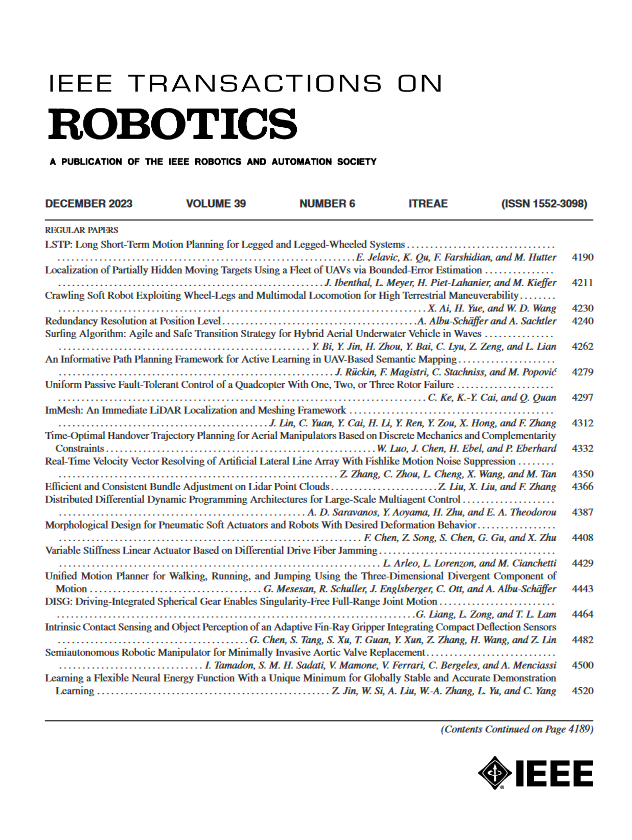概率反馈控制方法增强了崎岖地形上的多足运动
IF 10.5
1区 计算机科学
Q1 ROBOTICS
引用次数: 0
摘要
由于机器人与环境相互作用的高度不确定性,在复杂地形上实现健壮的腿运动提出了挑战。两足和四足机器人的最新进展在崎岖的地形上表现出良好的机动性,但由于高质量中心和狭窄的支撑基础的静态稳定性较低,因此严重依赖传感器来保持稳定性(Ijspeert和Daley, 2023)。我们假设多足机器人系统可以利用额外腿的形态冗余来最大限度地减少穿越具有挑战性的地形时的感知需求。研究表明(Chong et al., 2023), (Chong et al., 2023),一个有足够多腿的多足系统可以在没有传感和控制的情况下可靠地导航嘈杂的景观,尽管速度低至每周期0.1体长(BLC)。然而,由于不同的环境相互作用,提高多足机器人在挑战性地形上的速度的反馈控制框架仍未得到充分探索。这种复杂性使得在这些高自由度系统中难以确定控制的关键参数。在这里,通过实验室和现场实验,我们证明了垂直体波动波有助于减轻影响机器人速度的环境干扰。这些发现得到了概率模型的支持。利用这些见解,我们引入了一个控制框架,该框架使用二进制地面接触传感器来监测地面接触模式,以估计地形的粗糙度。控制器根据肢体的平均实际与理想脚地接触比的偏差来调整垂直体波,在粗糙的实验室地形上实现了高达0.235 BLC的显著增强。我们观察到,与开环控制器相比,速度增加了50%到60%,速度变化减少了30%到50%。此外,控制器还可以在实验室外的复杂地形中运行,包括松树秸秆、机器人大小的岩石、泥浆和树叶。本文章由计算机程序翻译,如有差异,请以英文原文为准。
Probabilistic Approach to Feedback Control Enhances Multilegged Locomotion on Rugged Landscapes
Achieving robust legged locomotion on complex terrains poses challenges due to the high uncertainty in robot–environment interactions. Recent advances in bipedal and quadrupedal robots demonstrate good mobility on rugged terrains but rely heavily on sensors for stability due to low static stability from a high center of mass and a narrow base of support (Ijspeert and Daley, 2023).We hypothesize that a multilegged robotic system can leverage morphological redundancy from additional legs to minimize sensing requirements when traversing challenging terrains. Studies suggest (Chong et al., 2023), (Chong et al., 2023) that a multilegged system with sufficient legs can reliably navigate noisy landscapes without sensing and control, albeit at a low speed of up to 0.1 body lengths per cycle (BLC). However, the feedback control framework to enhance speed of multilegged robots on challenging terrains remains underexplored due to diverse environmental interactions. Such complexity makes it difficult to identify the key parameters to control in these high-degree-of-freedom systems. Here, using laboratory and field experiments, we demonstrate that a vertical body undulation wave helps mitigate environmental disturbances that affect robot speed. These findings are supported by probabilistic models. Using such insights, we introduce a control framework, which monitors foot–ground contact patterns on rugose landscapes using binary foot–ground contact sensors to estimate terrain rugosity. The controller adjusts the vertical body wave based on the deviation of the limb’s averaged actual-to-ideal foot–ground contact ratio, achieving a significant enhancement of up to 0.235 BLC on rugose laboratory terrain. We observed a 50% to 60% increase in speed and a 30% to 50% reduction in speed variance compared to the open-loop controller. In addition, the controller operates in complex terrains outside the lab, including pine straw, robot-sized rocks, mud, and leaves.
求助全文
通过发布文献求助,成功后即可免费获取论文全文。
去求助
来源期刊

IEEE Transactions on Robotics
工程技术-机器人学
CiteScore
14.90
自引率
5.10%
发文量
259
审稿时长
6.0 months
期刊介绍:
The IEEE Transactions on Robotics (T-RO) is dedicated to publishing fundamental papers covering all facets of robotics, drawing on interdisciplinary approaches from computer science, control systems, electrical engineering, mathematics, mechanical engineering, and beyond. From industrial applications to service and personal assistants, surgical operations to space, underwater, and remote exploration, robots and intelligent machines play pivotal roles across various domains, including entertainment, safety, search and rescue, military applications, agriculture, and intelligent vehicles.
Special emphasis is placed on intelligent machines and systems designed for unstructured environments, where a significant portion of the environment remains unknown and beyond direct sensing or control.
 求助内容:
求助内容: 应助结果提醒方式:
应助结果提醒方式:


